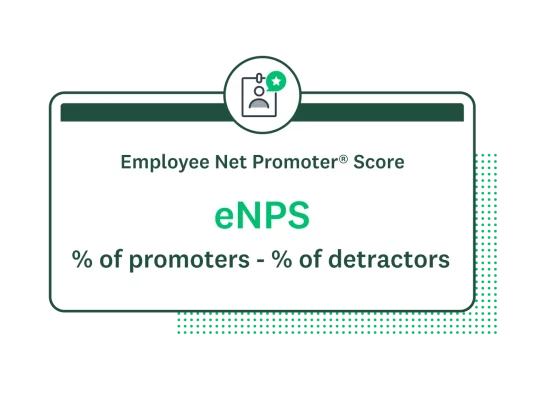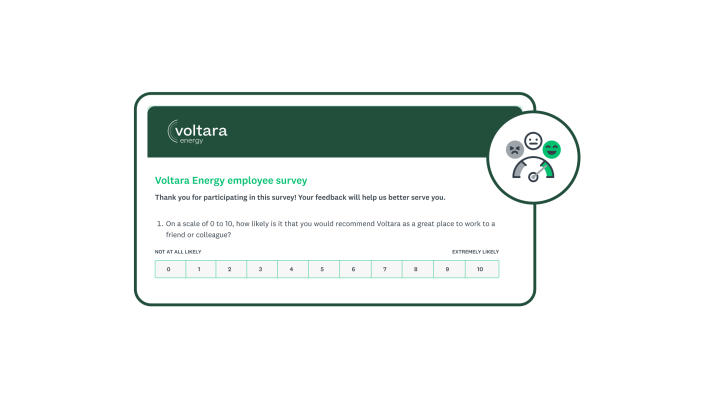Using eNPS to increase employee satisfaction and close the employee experience gap
Discover how to leverage surveys to track employee experience and close performance gaps over time.

Employee experience has become a key focus area for organizations today as they recognize its impact on employee engagement and retention. One metric that can help measure and improve employee experience is the employee Net Promoter Score (eNPS).
We’ll share what eNPS is, how it impacts employee experience, and best practices for using eNPS to measure and close the employee experience gap. With these strategies, companies can create a more engaging employee experience and improve their overall work culture.
What is eNPS, and how does it impact employee experience?
The employee Net Promoter Score® (eNPS) is a metric that measures how your employees feel about working for your company. It’s based on the Net Promoter Score® (NPS), a typical customer experience (CX) metric created by Bain & Company and Fred Reichheld to measure customer loyalty.
Every eNPS survey must include the main question: "On a scale of 0 to 10, how likely are you to recommend our company as a place to work?" Participants are categorized as promoters, passives, or detractors of a company based on their scores. To calculate your company’s eNPS score, subtract the percentage of detractors from the percentage of promoters. A high score suggests a positive relationship between employees and the company.

- "What is the primary reason for your score?"
- "How can we improve your experience at [company]?"
- "What do you like most about working for [company]?"
- "Do you feel valued and heard at [company]?"
- "Are you satisfied with your work-life balance?"
With these additional questions, HR professionals can easily identify areas of improvement and address challenges to their retention strategy. They can also gain insight into the factors that impact the employee experience, which can help them close significant gaps.
Best practices for closing the employee experience gap with surveys
Several methods exist to address employee experience gaps, but surveys can be a cost-effective and engaging way to understand employee perceptions of the company.
Consider these best practices when using surveys to measure employee experience:
Run eNPS surveys regularly
Businesses often use eNPS surveys to measure and track employee engagement and experience over time. Regularly monitoring eNPS scores can help Human Resource (HR) teams address gaps in the employee experience and can provide valuable insights into the effectiveness of your HR strategy. If your score is lower than expected, you may need to improve your strategy.
Try to collect eNPS scores every three to four months. You’ll need enough time to analyze the results, address any feedback, and take action before deploying a new eNPS survey. Ideally, you want to see your score improve over time. If it doesn't, you should take a closer look at your strategy and determine what needs to change.

Employee engagement surveys often include questions about the company’s values, vision, mission, teamwork, innovation, managers, and executives. Try these surveys to gather feedback about your company’s culture and how well employees align with its mission:
Culture surveys
Culture surveys often include questions about the company’s core values, vision, mission, teamwork, innovation, managers, and executives. Use templates for organizational culture, work-life balance, and compensation benefits surveys to understand how well employees connect with current policies.
Use your culture surveys to ask questions like:
- "How satisfied are you with your work-life balance?"
- "How would you describe your management’s overall work style?"
- "How satisfied are you with the benefits offered by this company?"
Employee satisfaction surveys
Employee satisfaction surveys can help you measure your team’s satisfaction across different areas, including their favorite parts of their job, any workplace issues they’d like to see changed, and more.
Add these (or similar) questions to your employee satisfaction survey:
- "How meaningful is your work?"
- "How challenging is your job?"
- "How well are you paid for the work that you do?"
Pulse surveys
Employee pulse surveys are short and frequent surveys that you can use to track employee engagement consistently. These surveys typically consist of one to ten questions, making them easy and convenient for employees to complete. Regularly conducting pulse surveys gives you a real-time snapshot of how employees feel about your company.
Try these questions in your next employee pulse survey:
- "Overall, how much do you like working at this company?"
- "How well do your job responsibilities match your strengths?"
- "If you could change one thing about your job, what would it be?"
Performance-based surveys
Use performance-based surveys to collect employee feedback about their managers, direct reports, and colleagues. These surveys are also useful for providing feedback to employees about their current performance. Helpful performance surveys include 360-feedback surveys, stay interview surveys, and exit interview surveys.
Consider these questions when building out your performance surveys:
- "How often does your team meet its deadlines?"
- "What do you like least about your job?"
- "What actions can the company take to build a better workplace?"
Analyze feedback and results
Review the data you collect to determine the most pressing areas of improvement. Look for common themes, grievances, or requests for services or benefits you’re not currently offering that you can provide. You can also use the data collected to create benchmarks you can measure against in the future to better understand the effectiveness of your strategies.
Use advanced survey analysis tools, like charting, combined filters, and open-ended text analysis, to pick up on significant trends and patterns.
After analyzing employee feedback, create an action plan to address concerns. Deploy new strategies, measure their impact, and then communicate the plan to stakeholders.
Update materials and programs as needed
Continuous improvement of employee/HR programs is crucial for any organization that wants to stay competitive in today's fast-paced business environment. By constantly reviewing and updating these programs, companies can ensure that they provide their employees with the resources, support, and development opportunities they need to perform at their best.
Additionally, continuous improvement can help businesses identify and address any gaps or inefficiencies in their HR processes, ultimately leading to cost savings and increased productivity.
Close the employee experience gap with SurveyMonkey
Surveys are an effective tool for measuring employee engagement and experience. By following the best practices outlined above, organizations can improve the effectiveness of their surveys and make data-driven decisions to close the employee gap.
Learn how SurveyMonkey can help you enhance your employee experience and engagement with our eNPS survey template.
Net Promoter, Net Promoter Score, and NPS are trademarks of Satmetrix Systems, Inc., Bain & Company, Inc., and Fred Reichheld.
Track (and boost) employee sentiment with SurveyMonkey
Learn how SurveyMonkey can help you track and understand employee experience with surveys.
Discover more resources

HR toolkit: Make employee experience your competitive advantage
HR leaders can use this toolkit to help drive exceptional employee experiences.

How feedback drives organizational transparency and builds trust
Support organizational transparency by making sure all stakeholders have access to relevant, honest information

eNPS Benchmarks: Measure and Improve Employee Engagement
Understand what makes a good eNPS, how to measure it, and discover effective strategies to increase employee engagement and retention.

Employee satisfaction: Why it matters and how to improve
Satisfied employees are happier and more productive. Learn how to measure and boost employee satisfaction to create a workplace people love.